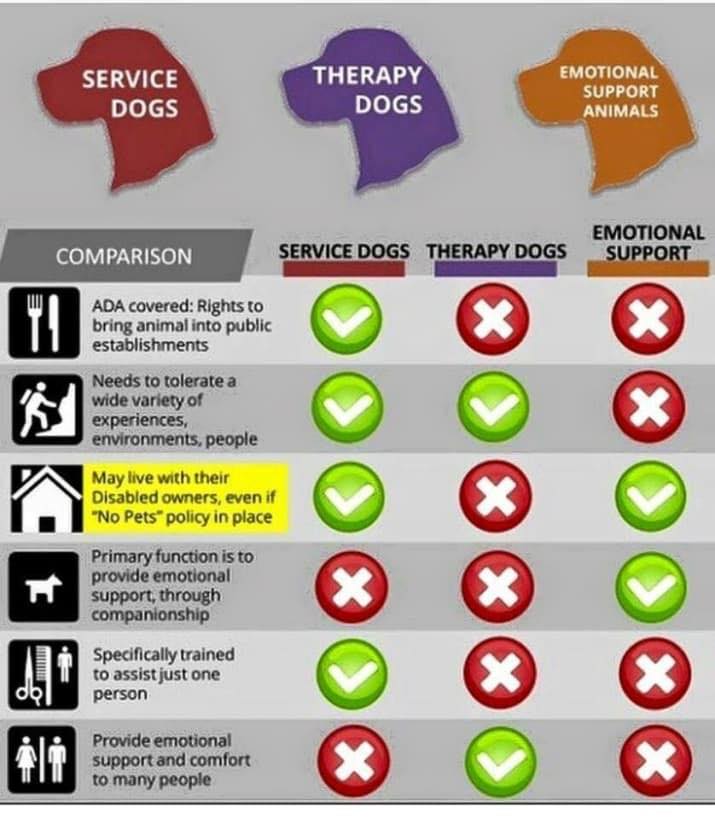Emotional Support Animal, Therapy Dog, or Service Animal? Is there a difference?
Posted on April 2, 2019 by Seren Maxwell No comments

I often get questions regarding Emotional Support Animals and Service Dogs, and I felt this was a topic worthy of discussion in our Wonderpup Journal . There are distinct differences between Emotional Support Animals (ESA), Service Animals/Dogs, and Therapy Animals/Dog, and it’s more than just semantics. Untrained pet dogs are being brought into public spaces under the title “ESA”, and worse, owners are even purchasing certificates and vests online and bringing their dogs into public places as their “service dog”. This is highly problematic and endangers true working teams, which we will discuss further in a little bit. So what is the difference between these designations, and what do you need to know?
🐶 An ESA (Emotional Support Animal) is prescribed to a patient by a mental health practitioner and requires a formatted letter (some places will accept a letter from a general practitioner). This letter must be on their letterhead, including their license information, state you are a patient under their care and have one or more mental illnesses that significantly impact your daily life and they prescribe an ESA to you. ESA’s require no formal training and there is no certification (if you see websites offering to certify your dog, those websites are a scam). They are allowed to live in housing where animals are not allowed and are exempt from pet fees, as long as the landlord owns more than four properties. They may fly on an airplane as long as they fall under the airlines regulations. ESA’s are still pets, and are not granted public access to places where pets are not allowed. This means your ESA can not go into stores such as Wal-Mart or restaurants. If the establishment has a “No Pet” policy, your ESA is not allowed to accompany you.
🐶 A Therapy Dog is a dog that has gone through training to provide comfort to many people such as at hospitals or nursing homes, they are still considered pets and do not have any public access rights or accommodations. This is a dog who accompanies their handler as a volunteer to bring comfort to many people. Therapy Dogs go through extensive training and testing and are certified through an organization. Organizations like Therapy Dog International and Pet Partners are two of the most popular. If an establishment has a “No Pet” policy, your therapy dog cannot accompany you.
🐶 Service Dogs are dogs that have been specifically task trained to assist their owner with a disability such as guide dogs, seizure alert dogs, or diabetic alert dogs. They are considered medical equipment and assist their disabled handler by performing tasks like alerting to oncoming medical episodes, retrieving items, helping their handler stand/walk, and even using a phone to call emergency services. There is no registration or certification for Service Dogs, any website offering to register your dog as a service animal is a scam. Service Dogs are covered by the ADA and may accompany their owner in public anywhere the public is allowed to go, on airplanes, and are exempt from housing regulations. Service Dogs are highly trained dogs and should have exemplary training, this dog when in public spaces will not, for example, jump on people or beg for food at a table. Their job is to keep their handler safe and assist them with the tasks they are trained for. While the ADA does allow for handler trained dogs, a novice team should train under the guidance of a professional. There are only two questions an establishment can legally ask a service dog handler “(1) is the dog a service animal required because of a disability? and (2) what work or task has the dog been trained to perform?” That’s it. A Service dog is not required to wear a vest while working, though most do. They are easily identified by their behavior when working in a public space. If you find a service dog is approaching you in a store without their handler, please follow them, they are likely trying to find assistance for their handler who is having a medical emergency.
So when you ask yourself, will putting a vest on your dog so you can take them out with you really hurt anyone else? I implore you to remember these stories, they are only two of many like them. Please, leave your dog at home.
If you have any questions about any of these designations please feel free to ask in the comments or refer to the ADA’s website.
